Abstract
This study explores methods to assess the benefits of WPHPP from three aspects: economic, environmental, and social. Decarbonization has become an inevitable trend in the electricity generation industry. Storage integrated renewable energy generation plants have enhanced the stability of the output of renewable energy to a certain degree. Wind power hydrogen production projects (WPHPPs) could be a promising solution to the Chinese government’s peak carbon dioxide emissions goal. To achieve this goal, an evaluation system consisting of 12 main benefits factors is established. Then, an assessment approach based on Cloud-MULTIMOORA is proposed to select the best alternative. Specifically, HELTS-Cloud model is used to describe the information given by decision-makers and experts. Then, the SWARA and CRITIC methods are applied to obtain the subjective and objective weights. Additionally, a constrained optimization model is introduced to obtain the comprehensive weights. Finally, the MULTIMOORA-EDA method is used to obtain the final ranking of alternatives. Additionally, a case study is made to certify the usability and feasibility of the proposed method. This paper provides a method for assessing the benefits of WPHPP and promotes the application of this new kind of green energy project in the future.
1. Introduction
WPHPP has a better performance from environmental and social perspectives. However, this better performance has not resulted in more significant investment. One of the obstacles to expanding this kind of project is that investment decision-making is exceptionally complex. There are many factors that have to be considered, such as economic, environmental, technical, etc. [1]. There are many benefits in investing in WPHPP, not only economically but also environmentally and socially [2]. However, there are not enough studies supporting this conclusion. Fossil fuel has been the prime energy source for over 200 years since the industrial revolution began. Along with the rapid development of the economy, and the unprecedented progress of technology, energy consumption has increased year by year. However, the current increasing speed of energy consumption is not sustainable, not to mention the environmental problems and global warming caused by the overuse of fossil fuels. Many governments have realized that a low-carbon energy structure is vital for our offspring, and many policies have been made. For example, the Chinese government’s carbon peak and carbon neutrality commitments could reduce carbon emissions significantly in the near future. However, due to the limitations of renewable energy, its application has encountered a bottleneck. Apart from technical reasons, there are some scheduling and dispatch problems that exist at the provincial level [3]. The proportion of wind power in the Chinese energy structure is shown in Figure 1. It is clear that the wind power installed in China has not reached its full potential.
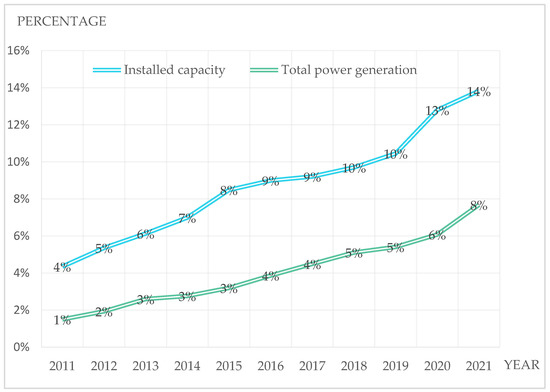
Figure 1.
Proportion of wind power in China from 2011 to 2021.
Wind power hydrogen production projects (WPHPPs) can potentially be one of the resolutions for wind power curtailment. Hydrogen has been used in industrial production for decades. However, the production of hydrogen mainly uses traditional fossil fuels [4]. Coal is mainly used in China for the production of hydrogen. According to Skoczkowski et al. [5], the CO2 emissions of producing hydrogen out of coal are twice as high as natural gas. Hydrogen from renewable energy is one of the most promising solutions by far. Many regions in China possess significant amounts of wind resources and have not exploited them sufficiently. For example, in Mongolia, the total wind energy reserves reached 89,800 kilowatts, and the wind energy technology development and utilization capacity were only 150 million kilowatts, accounting for 40% of the national available wind energy reserves. With those wind resources, a significant amount of green hydrogen can be produced. Industries such as full cells electric cars, and coal gasification could gain additional advantages in costing and carbon emissions.
In summary, there are many benefits to implementing WPHPPs with more significant efforts by both governments and investors. However, the lack of methods for assessing the benefits of WPHPPs is a substantial obstacle. This paper provides a method that potentially removes this obstacle. For governments, this paper provides a method for policymakers to evaluate the benefits of WPHPP and further make subsidy policies. For investors, this paper is a reference for achieving the best return of investment. The contributions of this paper are as follows:
- An evaluation system consisting of 12 main benefits factors for benefits assessment of WPHPP is established.
- A method based on the Cloud-MULTIMOORA approach is proposed for dealing with the problem and calculating the final result.
- Suggestions based on the findings of this paper are presented in the conclusions and outlook section.
The structure of this paper is as follows: Section 2 contains a literature review of the WPHPP and evaluation methods. Section 3 establishes the evaluation factors system for WPHPP. Section 4 introduces the methodology of this research. Section 5 is a case study carried out in Tibet, mainland China. Section 6 provides the conclusion and policy implications of this paper.
2. Literature Review
2.1. Review
Many studies have been carried out to assess wind power generation-based hydrogen production projects from various aspects. In the beginning, the project’s survival was the most critical factor. Because of this, early studies mainly focused on technical or economic assessment [6,7,8,9,10,11,12]. Some studies have begun to take the environmental aspect [13,14,15,16] into consideration as increasingly more people are becoming concerned about the planet’s environment. In this section, a thorough review of previous studies is carried out.
Because economic feasibility is among the major factors that determine whether a project can be launched, many studies take part in this research field.
Lotfi et al. [17] carried out research on the location of renewable energy optimization by considering risk. In other studies, Lotfi et al. [18,19] applied blockchain technology to solve a time-cost-quality-energy-environment tradeoff problem under resource-constrained conditions. Nordin and Abdul Rahman [20] carried out research about the optimal design of hydrogen production with renewable energy, specifically solar power. Additionally, some research, for example Rezaei-shouroki et al. [21] and Rezaei et al. [22], has assessed the technical reliability of hydrogen production with wind power. Zhang and Wan [23] researched the importance of hydrogen energy storage systems in addressing massive wind curtailment from an economic perspective. As increasingly more studies have proven the technical feasibility and justified the necessity of this technology, a lot more research has focused on its economic viability. Nematollahi et al. [7] assessed the techno-economic aspects of hybrid wind-solar utilization for hydrogen production. In addition, Boudries [24] examined whether hydrogen generation using PV energy was economically viable and according to their conclusion, the hydrogen production cost is reduced with a reduction in the cost of energy. Ali et al. [25] evaluated the economic viability of the hybrid energy system, and found that the levelized cost of electricity in the system is lower than the current tariff policy in Pakistan. Timmerberg and Kaltschmitt [26] carried out research about the economic aspects of producing hydrogen with sustainable energy such as wind or PV power.
With all these studies, the conclusion is clear that hydrogen storage systems cannot outperform conventional fossil fuels economically in the near future. However, from a sustainable perspective, fossil fuels must be saved for our offspring. Therefore, Rezaei et al. [27] found that with the installation of one set of Gamesa G47 turbines, 91 kg of hydrogen, which provides energy for 91 cars/week, can be produced in Manjil; in other words, about 1347 L of gasoline per week would be saved for the future. Ayodele et al. [28] found that by utilizing a wind-powered hydrogen refueling station in South Africa, CO2 and CO emissions could be reduced by 73.95 and 0.133 tons per year, respectively. According to Khalid et al. [13], a reduction of 2102.99 tons of CO2 emissions can be achieved using the turbine Gamesa G80 to replace an oil-burning power plant. In a different scenario, a reduction of 1518.41 tones of CO2 emissions can be achieved by replacing a natural gas-burning power plant. Awaleh et al. [29] found that 2061.6 tons of CO2/MW/year emissions could be saved using a “Yinhe GX113-2.5MW” wind turbine to replace the fuel-oil power plant. Qing et al. [30] carried out a study on the production of hydrogen with surplus wind power. The results showed that 2.19–3.29 million tons of standard coal consumption could be saved; 3.31–4.97 million tons of CO2, SO2, NOx, and PM emissions could be reduced; and 286.6–429.8 million yuan of environmental costs could be saved annually on average. Compared with the traditional coal-to-EG method, the CO2 emission intensity of hydrogen production from the coupling of wind/solar power will be reduced from 2.58 to 0.93 t/t-EG [31].
The development of a new kind of technology will impact on society. Acar et al. [32] found that the impact on public health is the most important factor while public acceptance is the least important for different hydrogen production options. Heras and Martín [33] carried out a study on the social issues in the energy transition. The results showed that half a million jobs will be created directly, and more indirect jobs will be created. According to Ortega et al. [34], the total employment of the wind and PV investment is expected to increase significantly, from 456,000 jobs in 2014 to 658,000 jobs in 2050. About half of those jobs will be created from wind power investment. Rezaei et al. [35] found that social awareness of wind energy has a positive effect on its acceptance as an electricity-generating source.
2.2. Research Gap
All the studies are listed in Table 1. The literature review shows that most studies in this area mainly focused on the economic or technical aspects of wind power hydrogen projects. Some studies have focused on the potential CO2 and other greenhouse gas emissions reduction by producing hydrogen from wind power. Last, some studies have researched the potential social benefit of switching to renewable power sources such as wind power. However, for governments and investors, more systematic and specialized studies need to be carried out to assess the benefit of WPHPP. Furthermore, despite the huge potential in the future energy supply and cleanness of wind power, no such paper has published in this area. This paper systematically assesses the economic, environmental, and social benefits of WPHPP.

Table 1.
Current research on this topic (✓ included in the study, - not included in the study).
3. Establishment of the Evaluation Factor System
To assess the benefits of WPHPPs, a reasonable evaluation criteria system is criterial. In this paper, the criteria system is based on three dimensions, including economic, environmental, and social. The first step is to identify the potential criteria through a literature study. Then, several experts who specialize in the energy environment, energy society, and energy economy were invited to identify sound criteria and the importance of those criteria based on their expertise. The unfit or relevant criteria were discarded. Finally, the benefit criteria systems for WPHPP were established. The details of these criteria are fully described as follows.
3.1. Economic Benefits
- (1)
- Initial investment increment. Compared with traditional wind power production projects, an increment in the initial investment in WPHPP is required.
- (2)
- Operation and maintenance cost. This means the costs in the operation period. All costs are included, such as employee salaries, repair bills, taxes, and other unexpected fees.
- (3)
- Payback period. The payback period is a crucial criterion investors care about a lot. This means the time needed to obtain all the investment back (including the initial, operation, and maintenance investment).
- (4)
- Cost per unit of H2. This criterion represents the cost per unit of H2 the project produces. It is important for the economic evaluation of WPHPP because it measures how much money is saved by the construction of this project.
3.2. Environmental Benefits
- (1)
- CO2 emission reduction. Compared with traditional hydrogen production methods, WPHPPs produce less CO2
- (2)
- Land usage. Wind power and hydrogen production require significant land usage. Though, it should be considered that most land usage is in rural areas.
- (3)
- Contaminants emission reduction. Compared with the traditional hydrogen production method, wind power emissions produce much fewer contaminants.
3.3. Social Benefits
- (1)
- Social acceptance. H2 is a kind of flammable, sometimes explosive, gas, which makes it hard to convince local residents to accept the projects. Meanwhile, this method produces fewer contaminants, which benefits locals. The construction and safe running would raise the social acceptance of more clean energy applications.
- (2)
- Labor influence. The construction and maintenance of WPHPPs would create new jobs that require new skills. Under the condition of economic growth recession, more jobs are needed in China to stabilize the society. Switching to clean energy such as WPHPP plays an important role in creating new job opportunities.
- (3)
- Contribution to energy security. The Russian-Ukraine war is still ongoing, and the US is sanctioning Russia, which is increasing concerns about energy shortage among governments, including the Chinese. The application of clean energy is a good option for the replacement of fossil energy.
- (4)
- Technology innovative promotion. Technologies for the construction and maintenance of hydrogen production via wind power are not fully matured and have not been tested or verified. The implementation of real projects would promote the development of and verify the technologies.
- (5)
- Regional disparity alleviation. Rapid development has been occurring in China for decades, but there are still many rural areas that are underdeveloped. However, some places are rich in wind resources. Constructing clean energy projects in these places would alleviate regional disparity.
The overall graphical demonstration is shown in Figure 2.
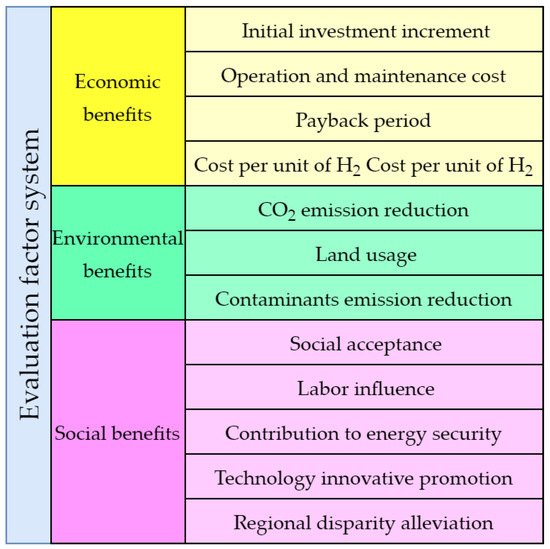
Figure 2.
Evaluation factor system of WPHPP.
4. Methodology
4.1. HFLTS-Cloud Model
In this section, a method based on the Cloud-MULTIMOORA approach is proposed to solve this MCDM problem. The MULTIMOORA method is applied to handle the judgments of DMs. However, there is vagueness and randomness rooted in human thoughts, and it is more accurate for DMs to provide their information in linguistic values. Hence the Cloud model is applied to describe the DMs’ decision information. Cloud-MULTIMOORA was chosen in this paper because it is more accurate and reliable when many human factors are involved. However, whether this method is suitable for other problems has not been verified, and this method is not suitable for problems without many human factors.
First, the basic definition of the hesitant fuzzy linguistic term set is explained. This part of the method describes the linguistic value collected from decision-makers or experts. Then, a method based on SWARA-CRITIC is proposed to determine the weight between different criteria. Finally, the MULTIMOORA-EDAS evaluation method is proposed to calculate the final ranking of the WPHPP alternatives. The exact steps are shown in the following flowchart in Figure 3.
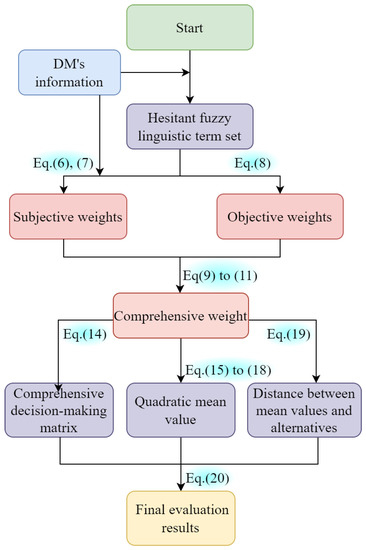
Figure 3.
The benefit assessment framework of WPHPP.
Definition 1 [36].
Letbe a set of linguistic terms that satisfy the following conditions:. Ifis a set of sequential languages representing the membership degrees of, thenis defined as a hesitant fuzzy linguistic term set.
A HFLTS could contain semi-structured information for evaluation such as “below…” or “above…”, and accurate information such as “moderate”. The subjective attitudes are then measured by linguistic terms represented by fuzzy measures, and the corresponding membership degrees of each term.
Definition 2.
Letbe the universe of discourse such as (0, 1) or (0, 100). If the membership function ofis expressed as shown in Equation (1), then the distribution of x in the universe I is defined as a cloud model [37]:
A cloud model is determined by three parameters, namely Ex, En, and He, respectively. Specifically, Ex is the expectation of the cloud model representing the central value of the cloud. En is the entropy of the cloud measuring the uncertainty of the distribution from the central value. Additionally, He is the hyperentropy of the cloud interpreting the uncertain degrees of entropy and the dispersion of the cloud droplets. Their relationship is expressed as follows [38]:
Suppose there are two clouds, namely and . The operational rules of the two clouds are defined as follows:
Additionally, to format the corresponding relationship between the linguistic values and distinct clouds, the golden section method [39] is utilized to generate a specific amount of clouds that represents the different levels of the evaluation results. Table 2 illustrates the relationship between them. The clouds are shown in Figure 4:

Table 2.
Linguistic terms and corresponding cloud models.
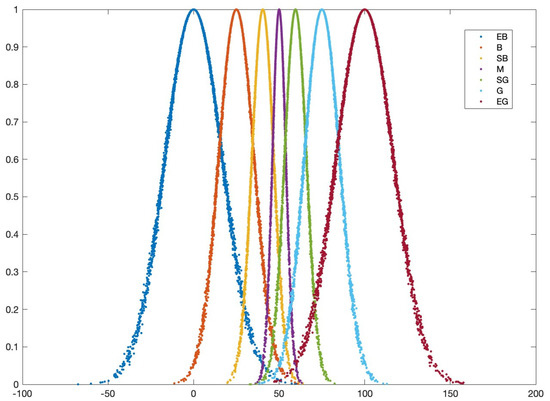
Figure 4.
Seven clouds of linguistic terms.
Additionally, the distance between two cloud models is calculated by the Manhattan distance [40], illustrated as follows:
4.2. SWARA-CRITIC Weight Determination
The subjective weight determination method is the step-wise weight assessment ratio analysis (SWARA) [41]. The first step is to obtain the ranking of the criteria based on the influence of the final results. The reference in this paper is the decision-makers’ preference. Then, the relative importance between the attribute (marked i) and the previous attribute (marked i − 1) is calculated. This value is the comparative influence of the values and the coefficient value is calculated for all attributes as shown in Equation (6):
Next, the subjective weights are calculated according to Equation (7):
For the objective counterpart, the criteria importance through intercriteria correlation (CRITIC) [12,42] is applied to obtain the objective weights. This method evaluates the weights according to the difference and the controversy degrees between alternatives. The prior step is to normalize the values according to their attributes, as shown in Equation (8):
Then, the variances and relation coefficients of alternatives under specific criteria are calculated as shown in Equations (9) and (10). Additionally, the objective weights are calculated according to Equation (10):
Furthermore, to obtain the comprehensive weight and reduce arbitrary judgement, a constrained optimization model is introduced. To achieve the minimum information loss, the final weight values need to deliver both subjective and objective information as much as possible. The model is interpreted as follows:
where cw, sw, and ow are the comprehensive weights, subjective weights, and objective weights, respectively. Then, the optimal solution is obtained by Lagrange duality theories. The combination is illustrated in Equation (13):
4.3. MULTIMOORA-EDAS Evaluation
The values obtained by the methods need to be aggregated into synthetical final results. This results in the method for the calculation of the second-stage comprehensive decision-making matrix :
where are determined by the ratio system, the distance to the reference point, and full multiplication, respectively [43], as shown in Equations (15)–(17):
To ensure the performances of the alternatives are more comparable, a comprehensive value should be obtained. The quadratic mean value is appropriate for this purpose:
To obtain each and every alternative’s performance, the distance between the alternatives and mean value should be calculated. Because the performance could be worse or better than the mean value, a negative and positive value should be calculated at the same time [44]. They are further aggregated by Equation (19):
The final evaluation results are obtained using Equation (20), where represents the preference of DMs:
5. Case Study
In this section, a real-world MCDM problem concerning the assessment of WPHPP economically, environmentally, and socially is proposed. The usability of the method in this paper is verified.
5.1. Background Information
In recent years, China has accelerated the process toward carbon neutrality. The short-term goal is to achieve peak carbon dioxide emissions. To achieve this, some compromises must be made, and some provinces have faced some electricity power shortages. The construction of renewable energy projects, such as wind power, could be a good solution to these electricity shortage. Based on the data provided by Chinese industry statistics, the installed capacity of renewable energy power reached 1 billion kilowatts by the end of 2021. However, because of the unstableness of renewable energy power, wind curtailment is still a great concern for investors and operators. H2 is an energy form that can easily be stored, which makes it a good solution for wind curtailment.
An experimental WPHPP is going to be carried out in China. There are several options in the Tibet autonomous region, located in southwest China, that have reached the standards for the project. Five potential projects are investigated, and the details are listed in Table 3. To maximize the benefits of the project, the selection between candidates must systematically assess the project economically, environmentally, and socially.

Table 3.
The information of five potential projects.
5.2. Assessment Based on the Cloud-MULTIMOORA Approach
From the information given, this is an MCDM problem that can be solved with the method proposed in this paper. In the following, the Cloud-MULTIMOORA approach is applied to solve this problem.
Step 1. Collect the original language values of each criterion of every project option. A questionnaire survey is conducted to obtain the primary data, in which six experts specializing in this area are invited, and four replies are received. The original data is shown in Appendix A Table A1. One of the experts is selected to give the subjective weight data, which is shown in Appendix A Table A2.
Step 2. Calculate the comprehensive weight. First, the subjective weight is calculated by Equations (6) and (7). The objective weight is calculated with Equations (9)–(11). Finally, the comprehensive weights are calculated by Equations (12) and (13). The results are shown in Figure 5.
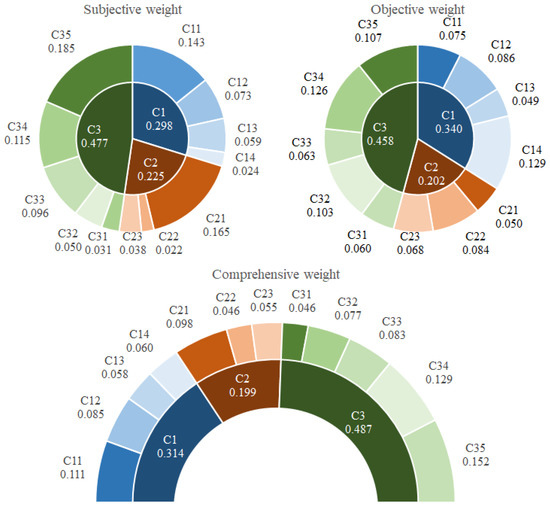
Figure 5.
Subjective, objective, and comprehensive weights of the benefit factors.
Step 3. The final ranking is calculated by Equations (14)–(20). First, according to Equation (14), the second-stage comprehensive decision-making matrix is calculated:
With Equations (15)–(18), the quadratic mean value is obtained. . With Equation (19), the positive and negative distance is calculated. The result is NP = (0.041, 2.302, 0.748, 0, 0)T, SP = (0.171, 0, 0, 0.773, 0.458)T.
In this paper, is 0.5. Finally, according to Equation (20), the evaluation value is shown in Figure 6.
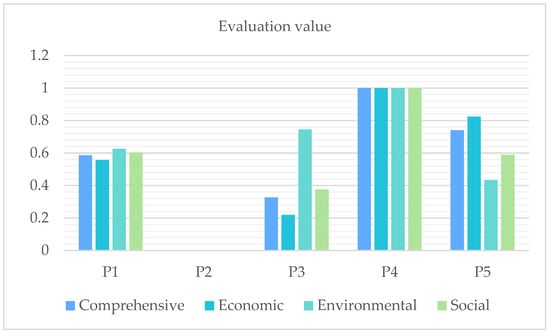
Figure 6.
The final evaluation values.
5.3. Results
It is intuitive to observe in Figure 4 that the sequence of these alternatives is P4 > P5 > P1 > P3 > P2, which gives potential investors and government policy makers a reference to decide which alternative is the best. For economic benefits, the ranking is P4 > P5 > P1 > P3 > P2. For environmental benefits, the ranking is P4 > P3 > P1 > P5 > P2. For social benefits, the ranking is P4 > P1 > P5 > P3 > P2.
5.4. Comparison of the Results without Social Factors
Considering social factors in benefits assessment is a vital value of this paper. Therefore, an evaluation without social factors is carried out to demonstrate the significance of social factors. As Figure 7 demonstrates, the ranking is changed to P4 > P3 > P1 > P5 > P2.
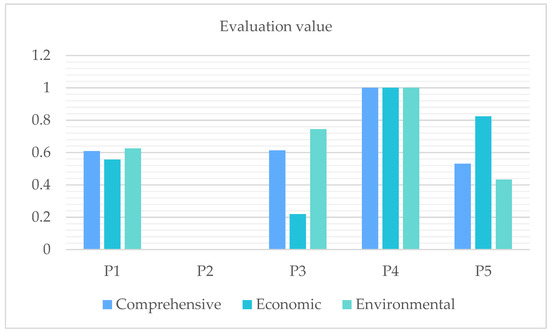
Figure 7.
The evaluation value without social factors.
5.5. Discussion
According to the case study results, WPHPP benefits locals not only economically but also has significant benefits regarding environmental and social aspects. Among these benefits, the social benefits are the most crucial for WPHPP. However, the economic benefits of WPHPP are not enough to support its construction and maintenance. Therefore, the government should consider the environmental and social benefits, and more support should be provided. Support policies such as feed-in tariff subsidies, tax incentives, and land transfers could be essential for WPHPP development. On the other hand, considering that more WPHPPs will be applied after more support policies are provided, the government should consider an evaluation system such as the one proposed in this paper to decide which project should be subsidized.
6. Conclusions and Outlook
6.1. Conclusions
Five potential WPHPP alternatives were investigated in this case study, and P4, located in Saga, was found to be the most beneficial regarding economic, environmental, and social benefits. From the results above, a few findings are proposed:
- WPHPP has significant potential, even though WPHPP cannot compete with traditional fossil fuels. With environmental and social factors considered, WPHPP is worthy of more government support and investment from energy suppliers.
- This paper constructed a benefit assessment framework for WPHPP, which provides policymakers and investors with a simple and reliable method to determine the optimal investment project.
- The social benefit factors were found to be the most important ones, followed by economic factors.
- When it comes to sub-criteria, four essential factors require special attention, including CO2 emission reduction, initial investment increment, technology innovative promotion, and regional disparity alleviation.
6.2. Outlook
Even though this paper considered social and environmental factors in the benefits assessment of PPWP, there are some limitations. First, more different methods should be applied to this topic to investigate if there are any improvements in the results. Then, more research should be carried out on other renewable energy resources to promote sustainable development. Last, but not least, more case studies should be carried out to verify the practicability of the method in this paper.
Author Contributions
Formal analysis, H.C.; Funding acquisition, Y.W.; Investigation, H.C.; Software, J.H.; Supervision, Y.W.; Writing—original draft, H.C.; Writing—review & editing, Y.Y., Y.H. and S.W. All authors have read and agreed to the published version of the manuscript.
Funding
This research is supported by the National Social Science Fund of China (19AGL027), the Fundamental Research Funds for the Central Universities (No. 2021MS022 and 2021PT013), and the 2017 Special Project of Cultivation and Development of Innovation Base (No. Z171100002217024).
Institutional Review Board Statement
Not applicable.
Informed Consent Statement
Not applicable.
Conflicts of Interest
The authors declare no conflict of interest.
Appendix A

Table A1.
Original data of the evaluation matrix.
Table A1.
Original data of the evaluation matrix.
| Expert | Project | C11 | C12 | C13 | C14 | C21 | C22 | C23 | C31 | C32 | C33 | C34 | C35 |
|---|---|---|---|---|---|---|---|---|---|---|---|---|---|
| E1 | P1 | SG | G | SG | M | M | SG | M | SG | SG | SG | G | SG |
| P2 | SB | B | SG | SG | SG | M | SB | M | B | B | M | B | |
| P3 | M | M | SG | M | M | SG | G | G | M | M | SG | SG | |
| P4 | G | SG | SG | G | M | G | M | SG | SB | SG | EG | EG | |
| P5 | M | G | G | EG | SG | M | M | SG | SG | M | SG | G | |
| E2 | P1 | M | SG | SG | M | SG | SG | M | G | M | SG | EG | M |
| P2 | B | B | M | G | SG | SB | SB | M | EB | B | M | EB | |
| P3 | SG | M | M | M | M | G | SG | EG | SB | SG | SG | G | |
| P4 | G | M | M | SG | SB | SG | SB | SG | B | M | EG | G | |
| P5 | SG | G | SG | EG | G | SG | SG | G | M | SB | M | G | |
| E3 | P1 | M | G | G | SB | SG | G | SG | M | G | G | G | M |
| P2 | B | EB | SG | M | M | M | B | SG | EB | SB | SG | B | |
| P3 | SB | SB | M | SB | M | SG | SG | G | SB | SB | M | SG | |
| P4 | G | G | SG | G | M | EG | SG | SG | B | G | EG | EG | |
| P5 | SB | EG | EG | G | M | M | M | G | G | SG | M | SG | |
| E4 | P1 | SG | EG | M | SB | SG | G | M | G | G | G | G | SG |
| P2 | M | SB | SG | G | M | SB | B | M | EB | B | M | B | |
| P3 | M | SG | M | SG | SB | G | G | SG | SB | M | SG | SG | |
| P4 | G | M | SG | SG | SB | EG | SB | M | SB | G | EG | G | |
| P5 | SB | SG | SG | G | M | M | M | SG | G | SG | SG | EG |

Table A2.
Data of the subjective weights.
Table A2.
Data of the subjective weights.
| Criterion | C11 | C12 | C13 | C14 | C21 | C22 | C23 | C31 | C32 | C33 | C34 | C35 |
|---|---|---|---|---|---|---|---|---|---|---|---|---|
| Ranking | 10 | 7 | 6 | 2 | 11 | 1 | 4 | 3 | 5 | 8 | 9 | 12 |
| Relative importance | 6 | 6 | 4 | 3 | 4 | 1 | 6 | 7 | 8 | 8 | 5 | 3 |
References
- Xu, C.; Wu, Y.; Dai, S. What are the critical barriers to the development of hydrogen refueling stations in China? A modified fuzzy DEMATEL approach. Energy Policy 2020, 142, 111495. [Google Scholar] [CrossRef]
- Wu, Y.; Xu, C.; Zhang, T. Evaluation of renewable power sources using a fuzzy MCDM based on cumulative prospect theory: A case in China. Energy 2018, 147, 1227–1239. [Google Scholar] [CrossRef]
- Zhang, H. Prioritizing Access of Renewable Energy to the Grid in China: Regulatory Mechanisms and Challenges for Implementation. Chin. J. Environ. Law 2019, 3, 167–202. [Google Scholar] [CrossRef] [Green Version]
- Lin, H.; Wu, Q.; Chen, X.; Yang, X.; Guo, X.; Lv, J.; Lu, T.; Song, S.; McElroy, M. Economic and technological feasibility of using power-to-hydrogen technology under higher wind penetration in China. Renew. Energy 2021, 173, 569–580. [Google Scholar] [CrossRef]
- Skoczkowski, T.; Verdolini, E.; Bielecki, S.; Kochański, M.; Korczak, K.; Węglarz, A. Technology innovation system analysis of decarbonisation options in the EU steel industry. Energy 2020, 212, 118688. [Google Scholar] [CrossRef]
- Arslan, O. Technoeconomic analysis of electricity generation from wind energy in Kutahya, Turkey. Energy 2010, 35, 120–131. [Google Scholar] [CrossRef]
- Nematollahi, O.; Alamdari, P.; Jahangiri, M.; Sedaghat, A.; Alemrajabi, A.A. A techno-economical assessment of solar/wind resources and hydrogen production: A case study with GIS maps. Energy 2019, 175, 914–930. [Google Scholar] [CrossRef]
- Yukesh Kannah, R.; Kavitha, S.; Preethi; Parthiba Karthikeyan, O.; Kumar, G.; Dai-Viet, N.V.; Rajesh Banu, J. Techno-economic assessment of various hydrogen production methods—A review. Bioresour. Technol. 2021, 319, 124175. [Google Scholar] [CrossRef]
- Al-Sharafi, A.; Sahin, A.Z.; Ayar, T.; Yilbas, B.S. Techno-economic analysis and optimization of solar and wind energy systems for power generation and hydrogen production in Saudi Arabia. Renew. Sustain. Energy Rev. 2017, 69, 33–49. [Google Scholar] [CrossRef]
- Mostafaeipour, A.; Rezayat, H.; Rezaei, M. A thorough investigation of solar-powered hydrogen potential and accurate location planning for big cities: A case study. Int. J. Hydrogen Energy 2020, 45, 31599–31611. [Google Scholar] [CrossRef]
- Mostafaeipour, A.; Khayyami, M.; Sedaghat, A.; Mohammadi, K.; Shamshirband, S.; Sehati, M.A.; Gorakifard, E. Evaluating the wind energy potential for hydrogen production: A case study. Int. J. Hydrogen Energy 2016, 41, 6200–6210. [Google Scholar] [CrossRef]
- Xu, C.; Ke, Y.; Li, Y.; Chu, H.; Wu, Y. Data-driven configuration optimization of an off-grid wind/PV/hydrogen system based on modified NSGA-II and CRITIC-TOPSIS. Energy Convers. Manag. 2020, 215, 112892. [Google Scholar] [CrossRef]
- Almutairi, K.; Dehshiri, S.S.H.; Dehshiri, S.J.H.; Mostafaeipour, A.; Jahangiri, M.; Techato, K. Technical, economic, carbon footprint assessment, and prioritizing stations for hydrogen production using wind energy: A case study. Energy Strategy Rev. 2021, 36, 100684P. [Google Scholar] [CrossRef]
- Apostolou, D.; Enevoldsen, P. The past, present and potential of hydrogen as a multifunctional storage application for wind power. Renew. Sustain. Energy Rev. 2019, 112, 917–929. [Google Scholar] [CrossRef]
- Bhandari, R.; Trudewind, C.A.; Zapp, P. Life cycle assessment of hydrogen production via electrolysis—A review. J. Clean. Prod. 2014, 85, 151–163. [Google Scholar] [CrossRef]
- Burmistrz, P.; Chmielniak, T.; Czepirski, L.; Gazda-Grzywacz, M. Carbon footprint of the hydrogen production process utilizing subbituminous coal and lignite gasification. J. Clean. Prod. 2016, 139, 858–865. [Google Scholar] [CrossRef]
- Lotfi, R.; Kargar, B.; Gharehbaghi, A.; Afshar, M.; Rajabi, M.S.; Mardani, N. A data-driven robust optimization for multi-objective renewable energy location by considering risk. Environ. Dev. Sustain. 2022, 1–22. [Google Scholar] [CrossRef]
- Lotfi, R.; Nazarpour, H.; Gharehbaghi, A.; Sarkhosh, S.M.H.; Khanbaba, A. Viable closed-loop supply chain network by considering robustness and risk as a circular economy. Environ. Sci. Pollut. Res. 2022, 1–20. [Google Scholar] [CrossRef]
- Lotfi, R.; Kargar, B.; Gharehbaghi, A.; Hazrati, H.; Nazari, S.; Amra, M. Resource-constrained time–cost-quality-energy-environment tradeoff problem by considering blockchain technology, risk and robustness: A case study of healthcare project. Environ. Sci. Pollut. Res. 2022, 1–17. [Google Scholar] [CrossRef]
- Nordin, N.D.; Rahman, H.A. Comparison of optimum design, sizing, and economic analysis of standalone photovoltaic/battery without and with hydrogen production systems. Renew. Energy 2019, 141, 107–123. [Google Scholar] [CrossRef]
- Rezaei-Shouroki, M.; Mostafaeipour, A.; Qolipour, M. Prioritizing of wind farm locations for hydrogen production: A case study. Int. J. Hydrogen Energy 2017, 42, 9500–9510. [Google Scholar] [CrossRef]
- Rezaei, M.; Mostafaeipour, A.; Qolipour, M.; Arabnia, H.R. Hydrogen production using wind energy from sea water: A case study on Southern and Northern coasts of Iran. Energy Environ. 2018, 29, 333–357. [Google Scholar] [CrossRef]
- Zhang, G.T.; Wan, X.H. A wind-hydrogen energy storage system model for massive wind energy curtailment. Int. J. Hydrogen Energy 2014, 39, 1243–1252. [Google Scholar] [CrossRef]
- Boudries, R. Analysis of solar hydrogen production in Algeria: Case of an electrolyzer-concentrating photovoltaic system. Int. J. Hydrogen Energy 2013, 38, 11507–11518. [Google Scholar] [CrossRef]
- Ali, F.; Ahmar, M.; Jiang, Y.; AlAhmad, M. A techno-economic assessment of hybrid energy systems in rural Pakistan. Energy 2021, 215, 119103. [Google Scholar] [CrossRef]
- Timmerberg, S.; Kaltschmitt, M. Hydrogen from renewables: Supply from North Africa to Central Europe as blend in existing pipelines—Potentials and costs. Appl. Energy 2019, 237, 795–809. [Google Scholar] [CrossRef]
- Rezaei, M.; Mostafaeipour, A.; Qolipour, M.; Momeni, M. Energy supply for water electrolysis systems using wind and solar energy to produce hydrogen: A case study of Iran. Front. Energy 2019, 13, 539–550. [Google Scholar] [CrossRef]
- Ayodele, T.R.; Mosetlhe, T.C.; Yusuff, A.A.; Ntombela, M. Optimal design of wind-powered hydrogen refuelling station for some selected cities of South Africa. Int. J. Hydrogen Energy 2021, 46, 24919–24930. [Google Scholar] [CrossRef]
- Osman Awaleh, M.; Adan, A.-B.; Assowe Dabar, O.; Jalludin, M.; Mahdi Ahmed, M.; Abdillahi Guirreh, I. Economic Feasibility of Green Hydrogen Production by Water Electrolysis Using Wind and Geothermal Energy Resources in Asal-Ghoubbet Rift (Republic of Djibouti): A Comparative Evaluation. Energies 2022, 15, 138. [Google Scholar] [CrossRef]
- Xue, Q.; Wang, Z.; Zhang, Y.Q. Environmental Benefit and Investment Value of Hydrogen-Based Wind-Energy Storage System. Front. Energy Res. 2021, 9, 13. [Google Scholar] [CrossRef]
- Shi, X.F.; Wang, Q.; Yang, S.Y.; Qian, Y. Low-Carbon Path of Geographically Matched Hybrid Energy Utilization: A Coal-To-Ethylene Glycol Process with Hydrogen from the Coupled Wind/Solar Power. ACS Sustain. Chem. Eng. 2021, 9, 4583–4599. [Google Scholar] [CrossRef]
- Acar, C.; Beskese, A.; Temur, G.T. Sustainability analysis of different hydrogen production options using hesitant fuzzy AHP. Int. J. Hydrogen Energy 2018, 43, 18059–18076. [Google Scholar] [CrossRef]
- Heras, J.; Martin, M. Social issues in the energy transition: Effect on the design of the new power system. Appl. Energy 2020, 278, 12. [Google Scholar] [CrossRef]
- Ortega, M.; del Rio, P.; Ruiz, P.; Nijs, W.; Politis, S. Analysing the influence of trade, technology learning and policy on the employment prospects of wind and solar energy deployment: The EU case. Renew. Sust. Energy Rev. 2020, 122, 17. [Google Scholar] [CrossRef]
- Rezaei, M.; Salimi, M.; Momeni, M.; Mostafaeipour, A. Investigation of the socio-economic feasibility of installing wind turbines to produce hydrogen: Case study. Int. J. Hydrogen Energy 2018, 43, 23135–23147. [Google Scholar] [CrossRef]
- Rosa, M.; Luis, M.; Francisco, H. Hesitant fuzzy linguistic term sets for decision making. IEEE Trans. Fuzzy Syst. 2012, 20, 109–119. [Google Scholar]
- Deyi, L.; Haijun, M.; Xuemei, S. Membership clouds and membership cloud generators. J. Comput. Res. Dev. 1995, 32, 15–20. [Google Scholar]
- Li, D.-y.; Liu, C.-Y.; Liu, L. Study on the universality of the normal cloud model. Eng. Sci. 2004, 6, 28–34. [Google Scholar]
- Wang, H.; Feng, Y. On multiple attribute group decision making with linguistic assessment information based on cloud model. Control Decis. 2005, 20, 679. [Google Scholar]
- Yb, G.; Xk, X.; Gf, L. Research on Linguistic Multi-attribute Decision Making Method Based on Normal Cloud Expectation and Variance Distance. J. Stat. Inf. 2021, 36, 12–19. [Google Scholar]
- Keršuliene, V.; Zavadskas, E.K.; Turskis, Z. Selection of rational dispute resolution method by applying new step-wise weight assessment ratio analysis (Swara). J. Bus. Econ. Manag. 2010, 11, 243–258. [Google Scholar] [CrossRef]
- Diakoulaki, D.; Mavrotas, G.; Papayannakis, L. Determining objective weights in multiple criteria problems: The critic method. Comput. Oper. Res. 1995, 22, 763–770. [Google Scholar] [CrossRef]
- Brauers, W.K.M.; Zavadskas, E.K. Project management by multimoora as an instrument for transition economies. Technol. Econ. Dev. Econ. 2010, 16, 5–24. [Google Scholar] [CrossRef]
- Asante, D.; He, Z.; Adjei, N.O.; Asante, B. Exploring the barriers to renewable energy adoption utilising multimoora-edas method. Energy Policy 2020, 142, 111479. [Google Scholar] [CrossRef]
Publisher’s Note: MDPI stays neutral with regard to jurisdictional claims in published maps and institutional affiliations. |
© 2022 by the authors. Licensee MDPI, Basel, Switzerland. This article is an open access article distributed under the terms and conditions of the Creative Commons Attribution (CC BY) license (https://creativecommons.org/licenses/by/4.0/).